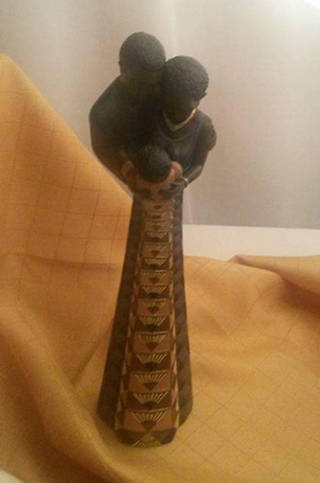By Morf Morford
Tacoma Daily Index
As I think about it, Christmas in 2020 strikes me as being very much like the very first Christmas.
What we now know as Christmas has virtually nothing to do with what that “starry” night looked like.
Christmas trees and swags, for example came later, centuries later in fact, thanks to Northern European pagan cultures – as did the idea of lights in the darkest season of the year.
Unless, of course, you consider Hanukkah, the eight-day Jewish festival where the followers commemorate the rededication of the second temple in Jerusalem during the 2nd century B.C.
The history of Hanukkah traces back over 2,000 years to the Maccabean Revolt, when Jews rose up to defend the Second Temple in Jerusalem from their Greek oppressors. In the middle of the revolt, legend has it, one night’s worth of oil was miraculously used to light the temple’s lamp for eight nights.
As one Jewish scholar put it, Hannukah is part of a larger story of rededication to something sacred and powerful following a period of terrible strife.
In other words, Hannukah is the season of lights and of reflection – and a time of deliberate acknowledgement and appreciation of others.
That would have been what, under normal circumstances, Mary and Joseph should have been celebrating.
They should have been home with their families. But as with 2020, nothing would go as planned.
A government “decreed” census required their relocation.
The Christmas story is so layered over with tradition and schmaltz that we can barely see it.
But we must remember that Mary was very young – possibly an early teenager, 13 or 14 perhaps.
Joseph was much older (you can see that most traditions recognize this by the “bearded” Joseph in most Christmas displays). Legend holds, (and cultural history confirms this) that Joseph, besides being older, had also been previously married. His first wife, as was all too common, had died during childbirth – but did leave him with children.
Most of us might think of Jesus as an only child, but he was far from it – and The Bible tells us so – Jesus had four named brothers: James, Joseph, Simon, and Judas (Matthew 13:55). The Bible go on to tell us that Jesus had sisters, but they are not named or numbered (Matthew 13:56). And in John 7:1-10, His brothers go on to the festival while Jesus stays behind. Most, if not all of these children were Joseph’s.
Again, Mary was vastly younger than her, ahem, husband.
As we know from history, culture and the biblical account, weddings and marriage were the defining features of an individual’s life – and a family’s identity.
And it was something that Mary did not have. But what she did have was a baby – visibly on the way.
To put it in common parlance, Mary has some ‘splaining to do.
And the first one she had to convince was Joseph – and even he didn’t believe her (Matthew 1:19-24).
As befuddled and frightened as Mary would have been, she was almost certainly glad to leave her small town. Where she was going, and for how long, who could say?
The king at that time was cruel, corrupt and willing to do anything to keep his crown – including murdering any threats to his kingdom – including any Jewish male children under two years old (Matthew 2:16).
He also killed several of his own children and his “favorite” wife (one of ten) to keep his throne.
This led to Mary and Joseph and the new baby fleeing the country and staying in Egypt for several years.
So consider this story so far; a crisis pregnancy, an unmarried mother, infanticide, political persecution, family shame, if not exclusion, and as we’d put it today, a blended family.
And I didn’t even mention crushing poverty, an arbitrary, paranoid and tempestuous king, and military occupation by the much-despised Roman Empire.
The king did have reason to fear for his life and throne. Several of his sons had attempted to take power.
Even the peasant girl Mary was a threat. Consider her Magnificat – for some reason rarely brought up in most Christmas pageants;
51 He has shown strength with his arm; he has scattered the proud in the thoughts of their hearts.
52 He has brought down the powerful from their thrones, and lifted up the lowly;
53 he has filled the hungry with good things, and sent the rich away empty.
Luke 1:51-53, New Revised Standard Version
It seems that, up until 2020, we celebrated everything except the loneliness, exile, vulnerability and uncertainty of that first Christmas, and because of that, we have missed the camaraderie, sense of discovery and yes, mutual, and often quiet appreciation of the ancient, foundational holidays.
When most of us can’t travel, or even gather, we can still appreciate each other, keep each other safe and maybe even encounter some aspects of ourselves or our family history, our usual Christmas busy-ness obscures and keeps us from seeing.
As the seeker, striver and yes, saxophone player, John Coltrane put it “I’ve been devoting quite a bit of my time to harmonic studies on my own, in libraries and places like that. I’ve found you’ve got to look back at the old things and see them in a new light.”
It’s interesting to me that so many faith traditions find their deepest sources in the darkest and coldest time of the year. A ‘new light” seems to be what we all need.
It’s almost as if we need to stop thinking about our own all-consuming schedules and obligations and open our eyes to the quiet, ineffable pulse beyond it all.
We often go to a Christmas Eve service which is almost always a Northern European, even British, brass and bell-driven celebration – usually triumphal and massive.
Once or twice I have appreciated it, but for the most part it makes me hungry for a quieter, subtler and maybe even acoustic experience closer to the sober longing for peace, restoration and home, and maybe even each other, that, perhaps after 2020, we will appreciate more as we see it in a new way.
However you commemorate this time of year, we wish you a restorative, encouraging time of renewal.






